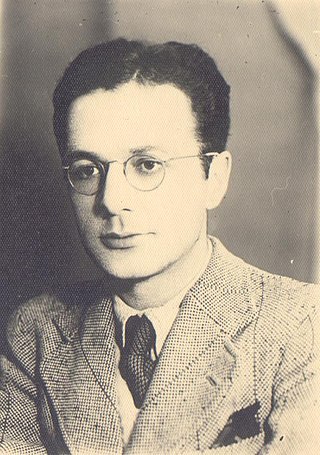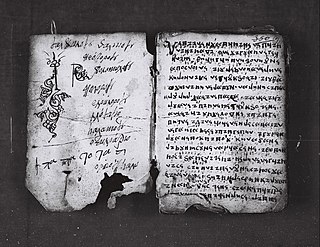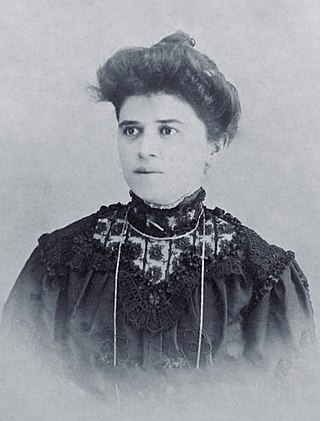Albanian literature stretches back to the Middle Ages and comprises those literary texts and works written in Albanian. It may also refer to literature written by Albanians in Albania, Kosovo and the Albanian diaspora particularly in Italy. Albanian occupies an independent branch within the Indo-European family and does not have any other closely related language. The origin of Albanian is not entirely known, but it may be a successor of the ancient Illyrian language.
The Elbasan alphabet is a mid 18th-century alphabetic script created for the Albanian language Elbasan Gospel Manuscript, also known as the Anonimi i Elbasanit, which is the only document written in it. The document was created at St. Jovan Vladimir's Church in central Albania, but is preserved today at the National Archives of Albania in Tirana. The alphabet, like the manuscript, is named after the city of Elbasan, where it was invented, and although the manuscript isn't the oldest document written in Albanian, Elbasan is the oldest out of seven known original alphabets created for Albanian. Its 59 pages contain Biblical content written in a script of 40 letters, of which 35 frequently recur and 5 are rare.

The General of the Dead Army is a 1963 novel by the Albanian writer Ismail Kadare. It is the author's most critically acclaimed novel. Kadare was encouraged to write the book by Drago Siliqi, literary critic and director of the state-owned publishing house Naim Frashëri. It was first published when the writer was 26 years old.

Dhimitër Beratti or Berati was an Albanian politician and journalist. One of the signatories of the Albanian Declaration of Independence Beratti served as secretary of the Albanian delegation at the Paris Peace Conference in 1919.
Dhimitër Xhuvani was an Albanian writer and screenwriter.

Dhimitër Shuteriqi was an Albanian scholar, literary historian, and writer. He participated in the anti-fascist National Liberation Movement. After the war, he was a member of the People's Assembly and one of the founders and later president of the Albanian League of Writers and Artists. In addition to a series of books and novels, he has published numerous volumes of textbooks, especially those on the History of Albanian Literature for high schools.

The Elbasan Gospel Manuscript is an 18th-century collection of translations from the New Testament into Albanian. Although the author is mainly known as the Anonymous of Elbasan, according to Mahir Domi and Robert Elsie the linguistic and historical evidences indicate to be the work of Gregory of Durrës. On the cover's verso with the same ink as the text, something has been written in a different script, which has been interpreted by a historian as ‘Theodoros Bogomilos / Papa Totasi’, although this tentative interpretation isn't universally accepted. For this reason the work is sometimes attributed to Totasi as the owner, if not the creator of the manuscript.
Drago Siliqi was an Albanian poet, literary critic, and publisher. At the age of 14 he became a scout and then a partisan of the National Liberation Movement. He published his first collection of poetry, and then pursued university studies at the Maxim Gorky Literature Institute in Moscow.
Komnen Arianiti was an Albanian nobleman of the Arianiti family, who held an area in central Albania around Durrës. His son Gjergj became a prominent leader of the Albanian-Ottoman wars.

Sevasti Qiriazi-Dako was an Albanian patriot, educator, Protestant missionary, author, pioneer of Albanian female education, and activist of the Albanian National Awakening.

Skënder Petro Luarasi was an Albanian scholar, writer and anti-fascist activist.

Lola GjokaAleksi was an Albanian pianist during the period of the Communist regime.
The Second Congress of Manastir was an Albanian congress held on 2–3 April 1910 in Manastir, back then Ottoman Empire, today's Bitola in the Republic of North Macedonia. It dealt with the challenges that the Albanian language and schools faced at the time within the context of the empire, and the platform to overcome them.

Gregory of Durrës was an Albanian scholar, printer, typographer, and teacher, and an Eastern Orthodox Christian monk and cleric of Ottoman Albania who is thought to have invented a particular Albanian alphabetic script, the Elbasan script, used to write the Elbasan Gospel Manuscript. The manuscript is one of the oldest known pieces of Albanian Orthodox literature, as well as the oldest known Orthodox Bible translation into Albanian.

Gjergj Pekmezi was an Albanian linguist, philosopher, folklorist and diplomat. In 1916, he became a member of the Literary Commission of Shkodër, which established the first standard form of the Albanian language.

Theodhor Haxhifilipi, also known as Dhaskal Todhri, was a teacher from Elbasan, who is credited as an inventor of an original Albanian alphabet. The Todhri script, as is called because of him, according to Kostandin Kristoforidhi, was either invented by Theodor, or brought by him from Voskopojë. Theodhor is the author of numerous translations of liturgical works in Albanian, of which only a few survived. A mass of John Chrysostom, preserved in a later manusrcipt of 32 pages, is amongst the rare ones kept at the National Library of Albania.
DhorkëOrgocka was an Albanian actress.
Xhesika Berberi is an Albanian model and beauty pageant titleholder, who was crowned Miss Universe Albania 2011 and represented Albania at the Miss Universe 2011.
Tole Lekë Berishaj is an Albanian-born costume designer, known as the last woman to knit Xhubleta.








